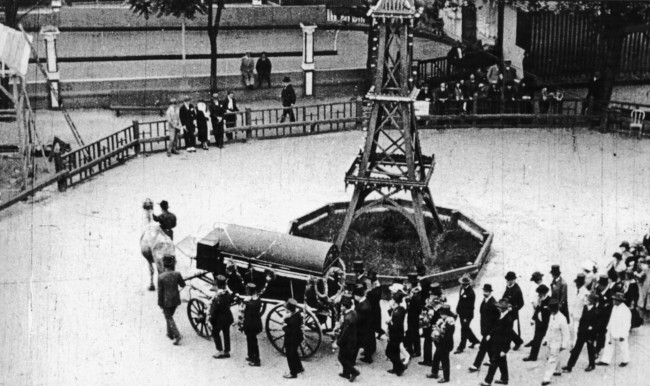Entr’acte
dir. by Rene Clair
Yes, this is an actual essay I recently emailed my History of Film professor, the wonderfully brilliant—and hopefully—well-humored Alison Griffiths. Please, enjoy as best as possible. It’s a lovely piece of self-indulgent esoteric.
* * *
the malleability of form and life, and perhaps death, too:
a study of entr’acte
as well as a discourse on avant-garde filmmaking betwixt World Wars
…
(if such a thing is even possible)
A fair warning for those who detest any and all manifestations of pretension: whenever I use quotation marks in the following “review/essay amalgamation thing” for Rene Clair’s 1924 short silent film Entr’acte, please regard the in-between content of those quotation marks ironically.
Or “should” you?
Who knows?
This is the avant-garde here, people. The weird. The strange. The unsettling. These are the movies—and other works of art—where nonsense prevails. Just like all the other avant-garde radicals operating out of ex-pat-heavy, post-War Paris—radicals like Man Ray, Salvador Dali, and Luis Bunuel (a coterie of surrealists whimsically portrayed in Woody Allen’s Midnight in Paris just three years back)—Rene Clair was intrigued by the seeming wonton nature of human society and its cyclical reflex for destruction and desolation. Unlike Dali and co., Clair was a native Franchie—nothing ex-pat about him. Clair—which was only a stage name—served as an ambulance driver during World War I before incurring a discharge-worthy spinal injury: so yeah, he knows a thing or two about carnage and mayhem at the service of “worldly preservation.” It was a rollickingly confusing time. People had no clue we—as a civilized whole—were capable of such a high body counts. We came after each other with greater efficacy than ever before. Here we were, as a people, just coming out of this seemingly forward-progressing development, Industrialism, thinking up new creations, new inventions, streamlining our production and development of goods to a scale never before experienced, and how did we end up using all this newly earned powers? By mowing each other down as quickly as possible. It’s like some side-standing spectator, timepiece in hand, cracked the skies with pistol fire and watched the rest of us race our ways to the ultimate finish line: oblivion. We took a giant step forward with Industrialism, only to regress once the Black Hand assassin Gavrilo Princip shot and killed the Archduke Franz Ferdinand of Austria setting off the first World War. Millions of people died—MILLIONS!—from machine gun fire, air raids, bomb detonations, mustard gas deployment—all those advances in weaponry that just two, three decades before were still rudimentary sketches on some engineer’s desk, and here they were on the battlegrounds of World War I executing their singular purpose: kill, kill, kill. No different than a factory line pumping out cars, one after the other, right on time. Murder, something that was typically regarded as a brutal and intimate—wholly personal—act of injustice, suddenly became another banal truth: a game of numbers, rather than lives. That’s a confusing concept, nearly impossible to cram into and process between our two ears. It was a remorseless blitzkrieg on humanity as a whole. Truly boggling stuff. Even after the War was over and done with, and the rubble and dust scattered and stacked in post-apocalyptic disarray over the length and width of a still-smoldering Europe, people kept scratching their heads in rumination, people like Bunuel and Dali, like Rene Clair, and asking: “Does any of this actually ‘mean’ anything?”
And that’s what the avant-garde artists set out to answer—in their own little, idiosyncratic ways.
I should probably go ahead and finally fill you in on the “plot” to Clair’s silent short, and I would really love to, but that would require roughly another hundred pages or so of esoteric rambling coupled with misguided supposition. The plot is so convoluted, so tangled, so outlandishly abstract, that it would do more harm than good to try and spell Entr’acte out in a cohesive, linear way. But hey, I’ll take a stab all the same. A very, very vague stab; instead, of describing the plot to you with concrete actions and verbs, I’ll pass it by you like an intangible cloud of modifiers and themes. Entr’acte is “about” the zany celebration of mortality—of life AND death—the whole damn kit and caboodle; it’s “about” the human condition, the human necessity to pathetically destroy one’s self, the human occupation with sprinting as fast as we can for the threshold that bridges the gap from existence to nonexistence; but most importantly, it’s “about” the illusiveness of perception, of reality, of the warped, nonsensical aftermath of World War I. That’s! what Entr’acte’s “about”.
Still following along?
Man, I hope so.
Like the avant-garde filmmakers before him—a fledgling group and movement of people interested in capturing the mindless abstractions of the post-War climate—Clair arranged his picture like a tapestry of bizarre, seemingly unrelated images; although, many would argue that Clair’s Entr’acte encrypts its mysteries more comprehensibly than Man Ray’s Le retour a la rasion or Fernan Leger’s Ballet mecanique. And it’s hypnotic, too, with beautiful use of slow motion. We see, through a thickly transparent slab of glass, the titillating contents of a ballerina’s tutu as she skips, twirls, pirouettes like a jellyfish stuck in ever-moving stasis. She flows like a water bound spirit, with the ebb and flow of a pureness we’ve done wonders to crush out of our collective system, like the wheel and the butterfly. And yet, she’s hopping up and down, directly above us; she’s moving, sure, but in place. From our perspective—other than her twirls and dancing feet—she remains still, on the same point of temporal placement, which works in great contrast to the later scenes of the “soldier’s” funeral when every member of the procession—decked out in their nicest, most formal duds: suits and ties, tall, tall top hats, bouncing white pearls, and bushy furs and caftans—runs after the coffin and buggy, chasing it—even longing for it. They race after the runaway buggy as it shoots and careens through Paris, their clothing and limbs flopping about hilariously—full of distress. But why are the distressed? Why do they wish to reach the buggy, the dead soldier—death itself—so quickly. All this motion, all this kinetic scurrying, leads to one finite end—the ultimate end: death. So like the dancer, we’re jumping, we’re flustering about, making all this racket, but for naught, because it’ll all lead to our eventual demise anyway. Which then leads us to the real question: with all the industrial innovations the world saw right before World War I, with all the progress in technology we supposedly created for our convenience, our health, our longevity—for you have to remember (as the new Soderbergh show Knick demonstrates) medical science was seeing a real boost in innovation, too, hence the uptick in life expectancy by almost 200-percent in the last century or so—did humankind really take all that huge a step forward only to obliterate life in droves? Because, as Clair reminds us in the first half of his short film, the world was still busy grieving for its soldiers. Roughly twenty million soldiers died during World War I. An odd way to react to the Industrial Revolution and the increased efficiency in health care that arose out of it: “Hey, lets just, like—I don’t know—kill everyone with all this new shiny shit we’ve tinkered up for ourselves!” So sure, we forged ahead, sprinted full tilt into the realm of science and efficacy, only to mow ourselves down. We create to destroy—two opposing forces, colliding, never moving. Perpetual paralysis, constant in-place motion. Like a dervish.
Like a ballerina.
But how do we know that it’s Industrialism Clair’s grinding his cinematic axe for?
Well, for one thing: there’s the giant phallic cannon that forcibly inserts itself from out of frame into the opening establishing shot of Paris. Before World War I, guns weren’t so quick or precise; they didn’t spray 600 bullets a minute like the Lewis gun. In that opening shot, Paris is reasonably calm, at peace, bustling as cities tend to do—when arrives the armament: a man made means of destruction. The canon dances and twirls and gives us a little jig, just as the ballerina eventually does, as if to say this canon, this thing, will be the end of us; given its sentient nature, it’s just as important as human life, if not more so. Even the suited men dance and jump with giddiness at the sight of their killing machine. The sight of them: a pair of bureaucrat-looking fellas deliriously geeking over a technological advancement that’s sole purpose is dole human and global tragedy. What’s the point of living in a society that glorifies such violent spectacles? What’s the point of adding years to our life’s expectancy if we’re mowing each other down so jubilantly?
At one moment we’re looking down the barrel of the gun and up into the skies, as if to say this is the future: us, and this machine. For it is a POV shot—from the cannon’s perspective, to be precise. But these are still our eyes we’re watching the film from, so it’s our perspective, too. We are complicit in whatever terrors this cannon produces. Then, later, once the suited gabbers prance back out of frame—looped in reverse to silly effect—the film cuts to an abrasive close-up of the cannon’s maw, gaping. The combustible violence below: concealed by darkness. The mouth of the cannon is hungry for us, ready to devour its own creator.
As for the jackanapes lighting the fuse and bouncing out of frame, it’s indicative of humanity’s inherent fear of accountability. As you’ll recall, there was a great heap of blame dropped upon Germany after the war. No one else wanted to admit that they had any part in contributing—negatively—to the mayhem. As that age-old adage goes: “history’s written by the victor, never the loser”—or something along those lines.
Listen, violence, the need to bash the other dude’s nose into his face, crunch his bone, bash, pound, spit, and yell, is inherent, it’s everlasting. We’ve all got the boxer in us, our fists always moving, ever ready for the lifelong spar, like those white gloves in a sea of black, in close-up, flashing in and out, overlapping, like a ghost, leaving traces of itself behind—like an echo reverberating through time—as civilization dissolves into the background, battered by its own penchant for barbarity. Clair seems to argue that the nature of violence—scratch that!—that the nature of war, of the vicious compulsion to pummel and let blood run, is a cyclical one. Hence the ballerina spinning in place, hence the world spinning topsy-turvy like a laundry machine right after we’re shot in the face by cannon fodder. Eventually, Clair makes his way to an edifice built like something out of ancient Roman times, with its classical architecture—columns and Doric Order and other such classical mumbo jumbo terminology—dissolving in, dissolving in, until all we see are columns across the screen, like bars. Prison bars. We’ve been imprisoned by our own institutions—the same institutions we thought were erected to protect us.
But hey! technology has its benefits, too. It’s simply awesome. Especially at the speed in which it’s developed—mind you, awesome is meant to be read archaically, you know, as in awesome: awe-inspiring, not the bastardized banality it’s been reduced to (may we please, please! re-re-appropriate this one, people?). The wealth of knowledge we contain, just in the palm of our hands, is astounding. And as these things go—since the cosmos (if you listen to the French) play so indifferently with us and ours—some use it for good, others for evil. And yes: there’re absolutely no in-betweens! This essay’s meant to be polemic! Weapons are around and they’ll always be around. In fact, they’ll get so sophisticated and so efficient one day that we might as well line up for the abattoir.
You see? The French understood all this. World War I was enough for them to see the existential dread that pervades our culture. It took the US a whole other war before they caught on—deploying the atom bomb will certainly do that—and reacted with Film Noir and its staple protagonist: the existential gumshoe—lost in a bottle of nothingness, led by his animal instincts, and unblinking at the sight of carnage. No…one war was enough for the French to “see” the “truth”.
Speaking of…lets shift gear, lets spin this baby around and approach it from a different angle now, drop all that context malarkey and discuss the abstractions of the avant-garde, of the conventions of narrative. But where to look from, what perspective. There’re so many to choose from. An infinite number of options, all of them with their own personalized rabbit hole.
Avant-garde, ain’t it?
But no, seriously: everyone’s seeing the same movie when watching a conventional film, and by conventional, I mean a narrative with roughly three acts, plot, structure, and characters who operate in relative agreement to the natural world order. The levels of literalness in conventional filmmaking are too high for people to ever vary in interpretations. Sure, people will disagree here and there, but at least they’ll be disagreeing upon similar subjects. That’s not the case with avant-garde films. Analysis is quite possibly limitless when it comes to the avant-garde. Avant-garde films like Clair’s Entr’acte or Anemic Cinema—or even Luis Bunuel and Salvador Dali’s Un Chien Andalou, the one with the famous eye-split scene—they effect the audience the same way a painting at the MET would. It’s there for bottomless scrutiny. Instead of a still canvas, we get a projection, both literally and figuratively. The film literally projects, through magnification and light, moving pictures onto a giant blank stretch of white vinyl, just as members of the audience project their already-fixed philosophies onto the movie and mold the “narrative” into whatever shape their id desires. Finally: a way to perceive a film as we perceive everything else in life: differently from the next guy. And if you know anything about the avant-garde of the post-World War I regime, you know that eyes and perception are the go-to themes and motifs—ah-hem! need I mention the unutterable disturbance of that Bunuel/Dali eye scene?
Ultimately, Entr’acte—which almost literally translates into intermission, which, in retrospect is awfully fitting for a movie chronologically bookended by both World Wars (an infinite jest, perhaps?)—reels along as a celebration of mortality. Not just life, but death, too. For the two are so hopelessly intertwined. It may be the aspect of existence common to the whole universe: life and death. That’s why when you see the procession of mourners—in addition to their Sunday’s best (and blackest)—they’re sporting garlands around their necks. It’s also why the film, despite its satiric subject matter, is cut with so much speed and whimsy, why the contents of the frame are so frenzied and action-packed, especially once the chase for the buggy picks up. Life’s brief. It’s, like, the blink-of-an-eye long—you know, in the greater scheme of things—like how a cut in a film looks: instantaneous. Apt then that the film closes with a magician who abracadabras the funereal runners out of frame. One moment we’re here, the next…well, perhaps that’s the one curiosity that’ll never be satisfied. Death: the one thing no one knows anything about, not for sure. That’s why when the film closes with the obligatory Fin, Clair busts the fourth wall—the image’s picture plane—Hulk style with a man hell bent on ridding the world of all intertitles, hammering home the uncertainty of what’s next—WHILE! simultaneously reminding us of the artifice of film and its limitations—and our own (like age and death and violence). Or maybe, just maybe, Clair’s playing the seer, Mr. Rene Clair-voyant (see what I did there?), and warning us of the cause of our demise, our Fin: our own recklessness.
It’s kinda hard to see how any of this could possibly be deemed wrong, how it could ever value as low as a pathetic F: all that text hanging above this paragraph—this paragraph right here, the one you’re reading at this very moment—since the point of Clair and Co.’s work is to break free of the tyranny of conventionality and easy definitions. Sure, sure, this is an essay and there should be some form of decorum, of order, of sense. But why? Who says that should be the case? In fact, it’d probably defeat the entire purpose of what I’ve been getting at here. And yes, I’m well aware I’ve taken up the first person point-of-view, which is one of the no-iest of no-nos when it comes to the dry-throated realm of academia, but seriously: my paper’s about those who said fuck all to structure and preordained, dogmatic principles and foundations and blah blah blah. So why shouldn’t I do the same. You know? Why shouldn’t I attempt a little tonal parallelism and write like they shot? If Clair’s allowed free reign to imp around, so should I.
Fin
But seriously: this is the avant-garde here, people. The weird. The strange. The unsettling…






